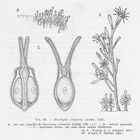WoRMS taxon details
Dicoryne Allman, 1859
117017 (urn:lsid:marinespecies.org:taxname:117017)
accepted
Genus
Dicoryne stricta Allman, 1859 accepted as Dicoryne conferta (Alder, 1856) (type by monotypy)
Heterocordyle Allman, 1864 · unaccepted (synonym)
- Species Dicoryne annulata von Lendenfeld, 1885
- Species Dicoryne conferta (Alder, 1856)
- Species Dicoryne conybearei (Allman, 1864)
- Species Dicoryne flexuosa Sars, 1874 accepted as Dicoryne conferta (Alder, 1856) (Synonym)
- Species Dicoryne stricta Allman, 1859 accepted as Dicoryne conferta (Alder, 1856) (synonym)
marine, brackish, fresh, terrestrial
recent only
Allman, G. J. (1859). Notes on the hydroid zoophytes. <em>Annals and Magazine of Natural History (3).</em> 4: 367-370., available online at https://www.biodiversitylibrary.org/page/2356509
page(s): 370 [details]
page(s): 370 [details]
Taxonomic remark It is unclear if this genus belongs to the Bougainvilliidae, Pandeidae or any other similar family is also possible. The...
Taxonomic remark It is unclear if this genus belongs to the Bougainvilliidae, Pandeidae or any other similar family is also possible. The position of the gonophores on the gonozooids is untypical. [details]
Schuchert, P.; Choong, H.; Galea, H.; Hoeksema, B.; Lindsay, D.; Manko, M.; Pica, D. (2025). World Hydrozoa Database. Dicoryne Allman, 1859. Accessed through: World Register of Marine Species at: https://www.marinespecies.org/aphia.php?p=taxdetails&id=117017 on 2025-05-04
Date
action
by
![]() The webpage text is licensed under a Creative Commons
Attribution 4.0 License
The webpage text is licensed under a Creative Commons
Attribution 4.0 License
Nomenclature
original description
Allman, G. J. (1859). Notes on the hydroid zoophytes. <em>Annals and Magazine of Natural History (3).</em> 4: 367-370., available online at https://www.biodiversitylibrary.org/page/2356509
page(s): 370 [details]
original description (of Heterocordyle Allman, 1864) Allman, G. J. 1864c. On the construction and limitation of genera among the Hydroida. - Annals and Magazine of Natural History (3) 13: 345-380., available online at https://www.biodiversitylibrary.org/page/22217607
page(s): 365 [details]
basis of record van der Land, J.; Vervoort, W.; Cairns, S.D.; Schuchert, P. (2001). Hydrozoa, <B><I>in</I></B>: Costello, M.J. <i>et al.</i> (Ed.) (2001). <i>European register of marine species: a check-list of the marine species in Europe and a bibliography of guides to their identification. Collection Patrimoines Naturels,</i> 50: pp. 112-120 (look up in IMIS) [details]
page(s): 370 [details]
original description (of Heterocordyle Allman, 1864) Allman, G. J. 1864c. On the construction and limitation of genera among the Hydroida. - Annals and Magazine of Natural History (3) 13: 345-380., available online at https://www.biodiversitylibrary.org/page/22217607
page(s): 365 [details]
basis of record van der Land, J.; Vervoort, W.; Cairns, S.D.; Schuchert, P. (2001). Hydrozoa, <B><I>in</I></B>: Costello, M.J. <i>et al.</i> (Ed.) (2001). <i>European register of marine species: a check-list of the marine species in Europe and a bibliography of guides to their identification. Collection Patrimoines Naturels,</i> 50: pp. 112-120 (look up in IMIS) [details]
Taxonomy
redescription
Schuchert, P. (2007). The European athecate hydroids and their medusae (Hydrozoa, Cnidaria): Filifera part 2. <em>Revue suisse de Zoologie.</em> 114: 195-396.
page(s): 241 [details]
page(s): 241 [details]
Other
 Present
Present  Inaccurate
Inaccurate  Introduced: alien
Introduced: alien  Containing type locality
Containing type locality
From editor or global species database
Diagnosis Colonial hydroids, branched or not, perisarc not ensheathing bases of tentacles; hydranth with one whorl of filiform tentacles; gonophores on specialized blastostyles replacing a hydranth, numerous, released as swimming ciliated sporosacs provided with one or two tentacle-like processes at their proximal end (tentaculoids). [details]Taxonomic remark It is unclear if this genus belongs to the Bougainvilliidae, Pandeidae or any other similar family is also possible. The position of the gonophores on the gonozooids is untypical. [details]
| Language | Name | |
|---|---|---|
| Japanese | オタマヒドラ属 | [details] |










